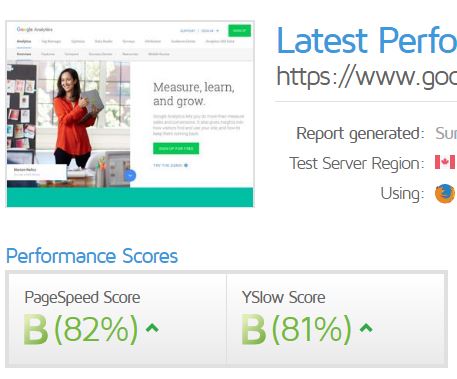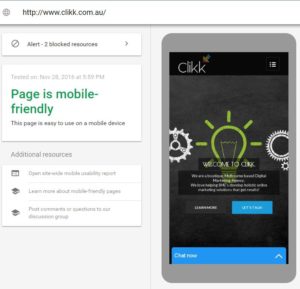Your website is the central piece in your digital marketing strategy, and if it is going to be effective in that role, it needs to be meeting some basic requirements.
For a great user experience, your website needs to be:
- Fast
- Friendly
- Attractive
- Providing value
Why are these factors so important?
If you don’t have a fast and functional website, you are more likely to be missing out on the full benefit of your digital marketing. If you are paying to send visitors to your site from AdWords or social media, you want them to have the best experience possible: deliver the opposite and you are potentially wasting money and losing that visitor forever.
In this blog, I’m going to give you some tools to help you make sure your website ticks all these boxes.
GTMetrix
GTMetrix is a free tool which scans your website and gives it a percentage score based on how well optimised your site is for a loading time. Simply type in your URL, and this tool will let you know what areas you can fix in order to improve the overall speed on your site.
There’s a ton of information available in this app, but try not to get too hung up on the data, one of Google’s sites only rates a B!

In many cases, image size is a major cause of site speed issues, so we’ll use the reports around image size, compression and scaled images as an example of what you will learn with GTMetrix.
I’ve done a check on a local competitor who offers SEO services and claims “We can get you to #1”. When I ran the site through GTMetrix, however, their SEO score was anything but #1. Not that ours is perfect, but really guys.

According to GTMetrix, their images need optimising – bad! But why is it so important to scale and compress your images?
Google dislikes slow websites
When Google sends traffic to your website from its search results, it wants the user experience to be as good as it can possibly be. The principle is, if people don’t like what Google recommends, they will stop using Google.
If your website is slow, Google won’t want to send people there for a poor experience so you will probably get a lower search ranking score from Google (it’s more complicated than that, but that’s it in simple terms).
People dislike slow websites
6 seconds.
That’s how long you have to get someone’s attention when they land on your website.
If 5 of those seconds are loading your mega-gigantic unoptimised slider of not-quite awesome, you’ve probably just lost them. Slow sites really suck especially when you are on your mobile device with poor reception (your site is mobile friendly right?), so using fully optimised images so your site loads quickly makes everyone happy.
Overall, GTMetrix is great at finding lots of things to tweak. Just focus on the easy stuff and maybe consider moving your web hosting as that can make a really big difference too.
Just remember, there’s always more to fix and some things you simply can’t fix at all.
Is your site mobile friendly?

Hurray! Our website is friendly to mobiles according to Google’s mobile test tool.
Just in case you’ve not been following the marketing reports, mobile is a really big deal now. Businesses are finding the up to 70% of their website traffic comes from mobile so having a website which performs well on multiple platforms and devices is very important.
Whilst you can do some simple fixes to try and get your website mobile friendly, this tool can help you evaluate your site to make sure that everyone on a mobile or tablet gets a great experience.
The same issues as I mentioned previously still apply.
- Google doesn’t like bad user experiences
- People don’t like bad experiences either
If you are unsure how to fix your website, it’s become far easier to move a non-complex site over to WordPress than it used to be, so it doesn’t have to be an expensive fix.
Facebook and Social Appearance (Open Graph)
Go to Facebook and start a new post. In that post type www.clikk.com.au and hit return (don’t post it unless you feel like telling people about us).
Now do the same with your website, but don’t forget the www. at the beginning or it won’t work.
If you’re lucky, you’ll get an appropriate image, if you’re not, you might get something completely off-brand.
This is fixed by using code called Open Graph.
Whilst this isn’t quite in the same league as the other two fixes, it does lend credibility to your brand.
Whenever someone mentions you on social media, you’ll get something that looks a bit better than one that isn’t optimised.

This tool may be a little beyond some people who don’t have any coding knowledge, but it is a quick job for your web-developer (don’t believe them if they tell you otherwise) or, if you are using WordPress there are a number of pugins available that can help get this sorted.
Google Analytics
I saved the best till last.
Google Analytics is the premium tool for getting a real picture of what is happening on your website. If you don’t have Google Analytics installed on your website or you don’t have access to it, cross whoever built your website off your Christmas card list. Getting your Google Analytics code installed is easy if you’re on WordPress and a little bit trickier if you’re not but still not a big task.
Google Analytics can provide you with key information to help drive your digital marketing efforts with statistics such as how many new sessions were started on your site over a given period of time, how many individuals visited the site and how many times they visited, which pages they visited and how many bounced. For most pages, a high bounce rate is bad as it means they didn’t interact with the page. So for sales pages over 75% is not good, however for a blog page where people just read, it’s not such a problem but you should always try to encourage people to click on something.

Whilst it has a steep learning curve, if you’re serious about marketing your business online, it’s worth getting at least a working knowledge of the key statistics you can learn in Google Analytics, to keep in touch with how your website is performing. Google has a range of free training at Google Analytics Academy, to help you on your way.
Need some advice on optimising your website to fit in with a comprehensive digital marketing strategy?



